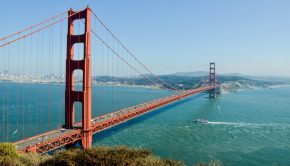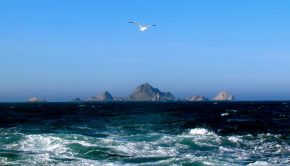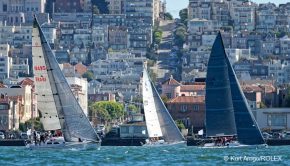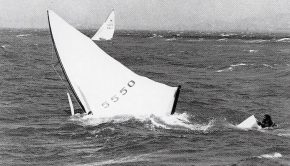Be wary of the San Francisco Bay
Published on February 2nd, 2022
Bill Barton recalls the summer of 1972 as one of the windiest in all his 48 years of sailing on San Francisco Bay. Here he shares the story of his introduction to this notable venue:
I had moved west from Rye and our light air Long Island Sound in January 1972 and my first racing opportunity on San Francisco Bay finally came later that summer. I got a call from an old friend and childhood competitor, Elliot Oldak, who planned to come west and sail in the United States Olympic Soling trials to be based at the San Francisco YC in Belvedere.
For the trials, I agreed without hesitation to do the middle of the boat even though my Soling experience was, at that point, limited. Elliot trailed out his boat and brought with him Knight Barton, who I knew by name only (and we were not related), but I liked his size and his attitude, and I had to admire the name.
Even though the Olympic trials for the Solings were to be sailed on the shallow waters of the Berkeley Circle, Elliot decided to hold our first practice in the deep water in the middle of the bay, off the City Front. One hundred and 50 feet deep as opposed to the 10- to 12-foot deep waters of the Circle.
For each of us, it was our first sail on San Francisco Bay, our first sail together as a team, and a day that we will never forget. It turned into a total disaster, and a near death experience for each of us.
We had four days to get this thing figured out ahead of racing the trials against a 45-boat fleet packed with an incredible Who’s Who from all over the United States.
Elliot was proud of the racing vests that he had fabricated for Knight and me, to increase our racing weight. He had sewn together seven sweatshirts for each of us, cut down the front with ties to join the sides. At the time I was 6′ 3″ and 200 pounds, while Knight was 6′ 1″and 230 pounds. When dunked in the water, each vest weighed over 50 pounds. Mine had a red logo, sewn heart on the back.
We launched the Soling at the San Francisco YC in Belvedere. I put on my sleeveless wet suit, sweatshirt vest, gloves, and sea boots and thought I was ready for action. We sailed out the harbor and then got our first big puffs of the blasting westerly breeze coming down over the Marin headlands.
As we got nearer to the west end of Angel Island the puffs were stronger. The water was cold. There was plenty of pressure and more ahead in the middle of the bay. By the time we had surfed across the bay, it was about 3:00pm and blowing a solid 20 to 25 knots from the west thru the gate with a big ebb tide chop.
At that time on Solings there were no hobbles, just hiking straps and handhold wells cut into the deck. To make it back into the boat from your over-the-side crouch, you had to rock your body hard and abruptly straight leg the straps, while jerking on the handholds. Adding to that the fifty soggy pounds of dripping sweatshirts strapped to your back made it a real effort.
To our astonishment there was not a single boat sailing that afternoon on the bay. Where were all the other Solings, our competitors? Why weren’t they out practicing? They were being smart we learned.
We made a plan to beat uphill for a mile from Gas House Cove, set a chute near the south tower of the Golden Gate Bridge, then run downwind for a spinnaker take down around the buoy at the cove, then beat back upwind again to the Crissy buoy near the Presidio shore. Then, according to the plan, we would enjoy a screaming reach home across the bay to Belvedere and San Francisco YC and a hot shower. The plan.
Well, we got up to Crissy and left the buoy to starboard and set our chute. We absolutely exploded with speed as the kite snapped open. Water was shooting off both sides in wide arcs and the sheets of spray power-washed my face. We surfed right on down to Alcatraz Island in a few adrenaline-filled minutes, and Elliot called for a gybe.
With the “Big Kahuna” Knight Barton on deck to gybe the pole, Elliot steered down, and the bow buried like a submarine in the next wave. We rounded down hard, crash gybing the main. All three of us were catapulted right out of the boat, and the boat was pinned on her side and filling rapidly with water. The tip of the mast was under water. Our gear was drifting away, including life jackets and paddles.
In a flash we knew that none of us was injured, but we were not all right. There wasn’t a potential rescue boat in sight, as we got oriented and focused. After swimming out from underneath the submerged mainsail, I unhooked the spinnaker from the halyard at the mast and then unhooked the main halyard at the tip. All three of us swam around to the keel side of the boat and put our weight on the keel and slowly helped the boat back onto her feet, with the mast finally rising up.
She was swamped and showing only about three feet of freeboard—floating, just barely—and the hull could only handle one of us inside to begin madly bucketing water out. We bailed and bailed, taking turns, and finally got ahead of the game so that a second person could climb inside and join the bailing effort.
Just then we saw another Soling sailing towards us from the City Front. As they streaked by asking if they could help, I could see that it was Lowell North with his crew, Kent Edler, and 300-pound Rodney Eals. We felt embarrassed but grateful that someone was there to help. We pointed 30 or 40 yards downwind to some of the boat’s equipment that was drifting away. They gathered the remainder of our stuff, and we asked them to stand by.
When we finally had the water down to floor-board level, we decided to re-hoist the main and try to sail out. I hung on to the rear of the cockpit with most of my body in the water to help keep the bow from diving if the bilge water surged forward. The gambit worked, and after a few minutes we had enough speed to open the automatic bilge bailers. Suddenly we were alive and kicking!
We signaled farewell to Lowell and began our reach across the bay, heading north for Belvedere. Lowell sailed back to St. Francis YC and never set his chute. Trial-by-fire. What an opening act! We were exhausted and humbled. Elliot asked, “What did we learn?” None of us could answer, but I knew that I had used one of my “nine lives,” and we damn well learned to be wary of the San Francisco Bay.
Editor’s note: Bill Barton is the author of ‘Legend of Imp’ which shares the story of this remarkable 40-footer designed by Ron Holland.









 We’ll keep your information safe.
We’ll keep your information safe.